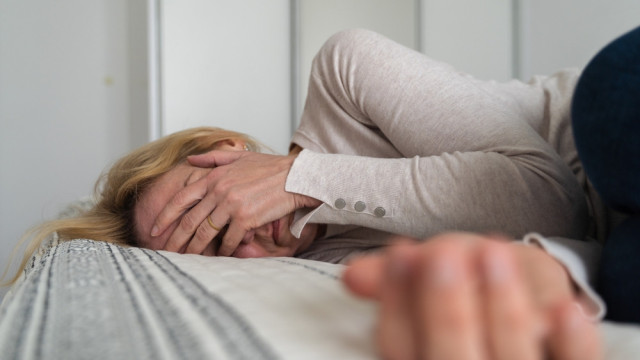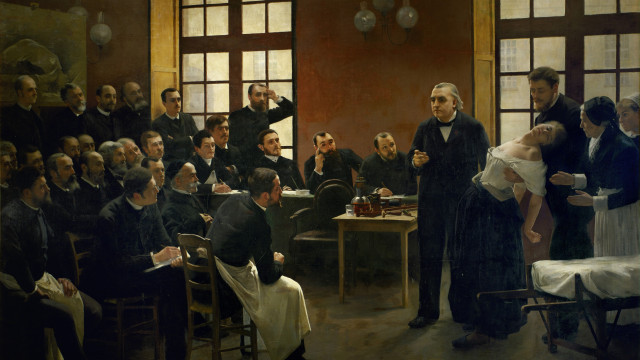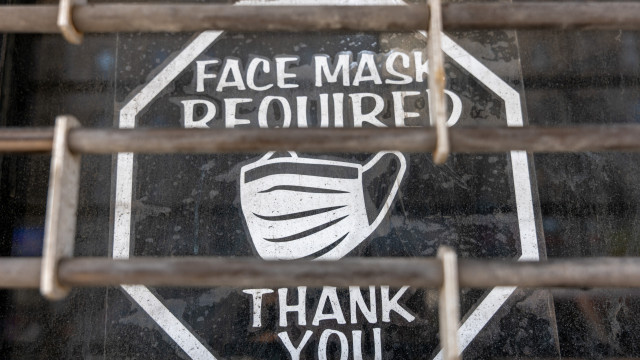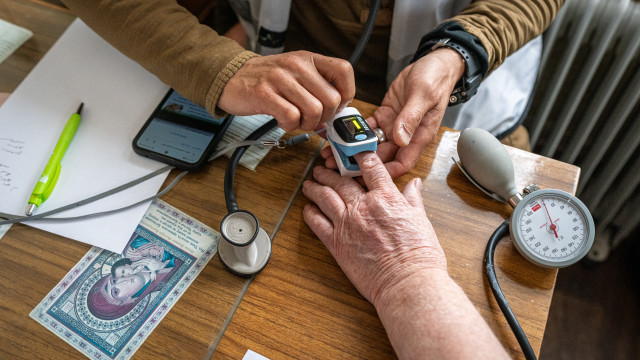



























See Also
See Again
Causes of pelvic pain and how to relieve it
- The pelvis is the area of the body below the abdomen. With many different organs and structures, such as blood vessels, nerves, the bladder, reproductive system and the bowel, there are many different causes of pain in the pelvis. And treatment will depend on the cause. Affecting both men and women, it might stem from infections, abnormalities in internal organs, or pain from the pelvic bones. In women, pelvic pain is often related to the reproductive system. In this gallery, let's discover possible causes of pelvic pain and how to relieve it. Click on for more.
© Shutterstock
0 / 28 Fotos
Endometriosis
- Endometriosis is a condition where tissue similar to the uterine lining grows outside the uterus. This tissue can bleed during someone's menstrual cycle, causing pain.
© Shutterstock
1 / 28 Fotos
Constipation
- Especially affecting the lower colon, constipation can cause pain. This type of pain tends to go away once a person has a bowel movement.
© Shutterstock
2 / 28 Fotos
Other intestinal problems
- A variety of other intestinal conditions can cause pain in the pelvis. These include irritable bowel syndrome (IBS), ulcerative colitis, and diverticulitis.
© Shutterstock
3 / 28 Fotos
Fibroids
- Fibroids are benign, noncancerous growths in the uterus. They can cause pain throughout the pelvis and lower back.
© Shutterstock
4 / 28 Fotos
Pelvic inflammatory disease (PID)
- PID is an infection that occurs in the female reproductive system, usually caused by an STI. PID causes pelvic or low back pain, as well as menstrual period changes.
© Shutterstock
5 / 28 Fotos
Scar tissue or adhesions
- Previous infections or surgical procedures can cause the formation of scar tissue or adhesions in the pelvis. This can result in chronic pelvic pain.
© Shutterstock
6 / 28 Fotos
Sexually transmitted infections (STIs)
- Most STIs don't cause any symptoms. But some, like chlamydia and gonorrhea, can cause pelvic cramping or pain.
© Shutterstock
7 / 28 Fotos
Ovulation pain
- Also known as mittelschmerz, ovulation pain causes slight to moderate discomfort during the middle part of a menstrual cycle.
© Shutterstock
8 / 28 Fotos
Prostate problems
- The prostate sits low in the pelvis. Inflammation or infection of the prostate can cause pelvic pain. A growth on the prostate can also cause discomfort.
© Shutterstock
9 / 28 Fotos
Menstrual cramps
- Menstrual cramps occur in the lower part of the pelvis. It tends to start just before a individual's period and may continue for a few days. Severe cramps can be an underlying condition, such as endometriosis or adenomyosis.
© Shutterstock
10 / 28 Fotos
Appendicitis
- The appendix is located in the lower abdomen. It can cause pelvic or low back pain when inflamed and pressed against the colon.
© Shutterstock
11 / 28 Fotos
Muscle spasms in the pelvic floor
- The pelvis is made up of several muscles that support the bladder, reproductive structures, and bowel. And just like other muscles, the pelvic floor muscles can spasm, causing pain.
© Shutterstock
12 / 28 Fotos
Ectopic pregnancy
- An ectopic pregnancy is when a fertilized egg implants into the pelvis or abdomen outside the uterus. It's life-threatening and requires immediate medical care. Pain and cramping occur as it grows, pressing on nearby organs or nerves.
© Shutterstock
13 / 28 Fotos
Pregnancy loss
- While some cramping in early pregnancy is normal as the fetus grows, severe or long-lasting pain can be a sign of pregnancy loss.
© Shutterstock
14 / 28 Fotos
Kidney stones
- Stones formed in the kidney usually begin to make their way out through the ureters and bladder, which can cause severe pain in the lower pelvis.
© Shutterstock
15 / 28 Fotos
Urinary tract infection (UTI)
- Typical symptoms of a UTI are burning pain during urination and more frequent urges to urinate. Some people even experience pelvic pain or cramping.
© Shutterstock
16 / 28 Fotos
Pelvic organ prolapse (POP)
- POP is when the bladder or uterus drops into a lower position in the pelvis. It usually isn't a serious health problem, but it can be uncomfortable.
© Shutterstock
17 / 28 Fotos
Ovarian mass
- A growth on the ovary can cause pelvic pain, especially if it's pressing on the local nerves or organs. It could be a sign of an ovarian cyst, benign ovarian tumor, or ovarian cancer.
© Shutterstock
18 / 28 Fotos
Hernia
- A hernia is an opening where the internal organs can pass through. If the hernia occurs in a muscle in the lower pelvis, it can lead to pelvic pain.
© Shutterstock
19 / 28 Fotos
Pelvic congestion syndrome (PCS)
- PCS is a common cause of chronic pelvic pain in women of reproductive age. It's caused by problems with the veins in the pelvic area, as they become swollen and painful.
© Shutterstock
20 / 28 Fotos
Painful intercourse
- Women can experience pain during or after intercourse, either in their reproductive organs or deeper in the pelvis. This condition is also known by its medical name: dyspareunia.
© Shutterstock
21 / 28 Fotos
Interstitial cystitis
- Interstitial cystitis is a chronic bladder problem that causes pain in the lower pelvis. People with interstitial cystitis usually experience frequent and urgent needs to urinate.
© Shutterstock
22 / 28 Fotos
Vulvodynia
- Vulvodynia is persistent pain in the vulva. It can cause a burning and stinging sensation, including pelvic pain, that lasts for three months or longer. Treatment options range from medication to physical therapy.
© Shutterstock
23 / 28 Fotos
Chronic pelvic pain
- If you experience pain that lasts at least six months, then it's considered chronic. Sometimes, even after a lot of testing, the cause of pelvic pain remains a mystery. But it's still possible to manage the pain and discomfort once a person knows what is causing it.
© Shutterstock
24 / 28 Fotos
How to relieve pain
- In many cases, simple home remedies can help relieve some of the pain. These include placing a heating pad on the pelvis, taking pain relievers, and doing gentle exercise or stretching. It can also help to rest with the legs elevated, which promotes blood flow to the pelvis.
© Shutterstock
25 / 28 Fotos
Adenomyosis
- Adenomyosis is when endometrial tissue grows deep into the uterine muscle. This usually causes very heavy periods with severe pelvic pain.
© Shutterstock
26 / 28 Fotos
When to see a doctor
- However, when you're not sure what is causing the pain, then it's best to see a doctor. Particularly if you don't respond to home remedies, or if the pain is chronic. Sources: (Medical News Today) (WebMD)
© Shutterstock
27 / 28 Fotos
Causes of pelvic pain and how to relieve it
- The pelvis is the area of the body below the abdomen. With many different organs and structures, such as blood vessels, nerves, the bladder, reproductive system and the bowel, there are many different causes of pain in the pelvis. And treatment will depend on the cause. Affecting both men and women, it might stem from infections, abnormalities in internal organs, or pain from the pelvic bones. In women, pelvic pain is often related to the reproductive system. In this gallery, let's discover possible causes of pelvic pain and how to relieve it. Click on for more.
© Shutterstock
0 / 28 Fotos
Endometriosis
- Endometriosis is a condition where tissue similar to the uterine lining grows outside the uterus. This tissue can bleed during someone's menstrual cycle, causing pain.
© Shutterstock
1 / 28 Fotos
Constipation
- Especially affecting the lower colon, constipation can cause pain. This type of pain tends to go away once a person has a bowel movement.
© Shutterstock
2 / 28 Fotos
Other intestinal problems
- A variety of other intestinal conditions can cause pain in the pelvis. These include irritable bowel syndrome (IBS), ulcerative colitis, and diverticulitis.
© Shutterstock
3 / 28 Fotos
Fibroids
- Fibroids are benign, noncancerous growths in the uterus. They can cause pain throughout the pelvis and lower back.
© Shutterstock
4 / 28 Fotos
Pelvic inflammatory disease (PID)
- PID is an infection that occurs in the female reproductive system, usually caused by an STI. PID causes pelvic or low back pain, as well as menstrual period changes.
© Shutterstock
5 / 28 Fotos
Scar tissue or adhesions
- Previous infections or surgical procedures can cause the formation of scar tissue or adhesions in the pelvis. This can result in chronic pelvic pain.
© Shutterstock
6 / 28 Fotos
Sexually transmitted infections (STIs)
- Most STIs don't cause any symptoms. But some, like chlamydia and gonorrhea, can cause pelvic cramping or pain.
© Shutterstock
7 / 28 Fotos
Ovulation pain
- Also known as mittelschmerz, ovulation pain causes slight to moderate discomfort during the middle part of a menstrual cycle.
© Shutterstock
8 / 28 Fotos
Prostate problems
- The prostate sits low in the pelvis. Inflammation or infection of the prostate can cause pelvic pain. A growth on the prostate can also cause discomfort.
© Shutterstock
9 / 28 Fotos
Menstrual cramps
- Menstrual cramps occur in the lower part of the pelvis. It tends to start just before a individual's period and may continue for a few days. Severe cramps can be an underlying condition, such as endometriosis or adenomyosis.
© Shutterstock
10 / 28 Fotos
Appendicitis
- The appendix is located in the lower abdomen. It can cause pelvic or low back pain when inflamed and pressed against the colon.
© Shutterstock
11 / 28 Fotos
Muscle spasms in the pelvic floor
- The pelvis is made up of several muscles that support the bladder, reproductive structures, and bowel. And just like other muscles, the pelvic floor muscles can spasm, causing pain.
© Shutterstock
12 / 28 Fotos
Ectopic pregnancy
- An ectopic pregnancy is when a fertilized egg implants into the pelvis or abdomen outside the uterus. It's life-threatening and requires immediate medical care. Pain and cramping occur as it grows, pressing on nearby organs or nerves.
© Shutterstock
13 / 28 Fotos
Pregnancy loss
- While some cramping in early pregnancy is normal as the fetus grows, severe or long-lasting pain can be a sign of pregnancy loss.
© Shutterstock
14 / 28 Fotos
Kidney stones
- Stones formed in the kidney usually begin to make their way out through the ureters and bladder, which can cause severe pain in the lower pelvis.
© Shutterstock
15 / 28 Fotos
Urinary tract infection (UTI)
- Typical symptoms of a UTI are burning pain during urination and more frequent urges to urinate. Some people even experience pelvic pain or cramping.
© Shutterstock
16 / 28 Fotos
Pelvic organ prolapse (POP)
- POP is when the bladder or uterus drops into a lower position in the pelvis. It usually isn't a serious health problem, but it can be uncomfortable.
© Shutterstock
17 / 28 Fotos
Ovarian mass
- A growth on the ovary can cause pelvic pain, especially if it's pressing on the local nerves or organs. It could be a sign of an ovarian cyst, benign ovarian tumor, or ovarian cancer.
© Shutterstock
18 / 28 Fotos
Hernia
- A hernia is an opening where the internal organs can pass through. If the hernia occurs in a muscle in the lower pelvis, it can lead to pelvic pain.
© Shutterstock
19 / 28 Fotos
Pelvic congestion syndrome (PCS)
- PCS is a common cause of chronic pelvic pain in women of reproductive age. It's caused by problems with the veins in the pelvic area, as they become swollen and painful.
© Shutterstock
20 / 28 Fotos
Painful intercourse
- Women can experience pain during or after intercourse, either in their reproductive organs or deeper in the pelvis. This condition is also known by its medical name: dyspareunia.
© Shutterstock
21 / 28 Fotos
Interstitial cystitis
- Interstitial cystitis is a chronic bladder problem that causes pain in the lower pelvis. People with interstitial cystitis usually experience frequent and urgent needs to urinate.
© Shutterstock
22 / 28 Fotos
Vulvodynia
- Vulvodynia is persistent pain in the vulva. It can cause a burning and stinging sensation, including pelvic pain, that lasts for three months or longer. Treatment options range from medication to physical therapy.
© Shutterstock
23 / 28 Fotos
Chronic pelvic pain
- If you experience pain that lasts at least six months, then it's considered chronic. Sometimes, even after a lot of testing, the cause of pelvic pain remains a mystery. But it's still possible to manage the pain and discomfort once a person knows what is causing it.
© Shutterstock
24 / 28 Fotos
How to relieve pain
- In many cases, simple home remedies can help relieve some of the pain. These include placing a heating pad on the pelvis, taking pain relievers, and doing gentle exercise or stretching. It can also help to rest with the legs elevated, which promotes blood flow to the pelvis.
© Shutterstock
25 / 28 Fotos
Adenomyosis
- Adenomyosis is when endometrial tissue grows deep into the uterine muscle. This usually causes very heavy periods with severe pelvic pain.
© Shutterstock
26 / 28 Fotos
When to see a doctor
- However, when you're not sure what is causing the pain, then it's best to see a doctor. Particularly if you don't respond to home remedies, or if the pain is chronic. Sources: (Medical News Today) (WebMD)
© Shutterstock
27 / 28 Fotos
Causes of pelvic pain and how to relieve it
© Shutterstock
RECOMMENDED FOR YOU




























MOST READ
- Last Hour
- Last Day
- Last Week








